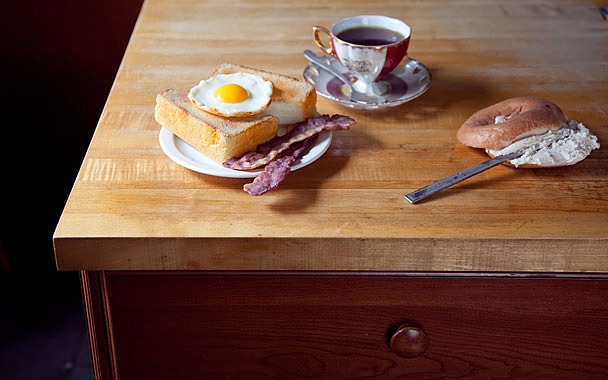It all started with Julia Child. Doesn’t everything related to food start with Julia Child, especially here in Cambridge, Massachusetts? I was a newlywed, living in Married Student Housing with my husband, a second-year law student. We were on a budget: He had part-time jobs tutoring a third-grader in the suburbs and driving a chapel-obsessed professor emeritus to every New England prep school campus within a 200-mile radius; I graded papers for a college English department and wrote book reviews for a tanking tabloid (circulation: my family and friends). But mostly I was raring to cook “gourmet”—sweet-and-sour hamburgers dotted with canned pineapple chunks; tuna casserole whose exotic sauce consisted of any canned soup that was on sale that week. On the way home from tutoring, my husband would pick up discount “meat” from a mom-and-pop grocery that guaranteed prices lower even than Filene’s Basement’s famed markdowns. I’d set one of the plump hamburger patties to sizzle on my wedding-gift Corningware pan and instantly it would shrink to the size of a silver dollar, bathed in the sweated-off emulsion of its own fat.
Except for those twice-a-week drive-by patty purchases, we tried not to tempt the engine of our cranky and unreliable 25-year-old Pontiac. As a result, my food buying was confined to the across-the-street market where Julia Child was on kissing terms with Jack the butcher. If we were lucky enough to visit the market on one of her shopping days, we’d gather round as she trilled advice from her imperious height, checking our grocery lists, suggesting cuts of beef. Did any rock star have more devoted groupies?
Though I pored over Mastering the Art of French Cooking, I was a realist, mixing together my down-market ingredients in recipes from 1,000 Ways to Cook Hamburger and a bunch of other cookbooks peppered with the words “easy” and “quick” and “foolproof.” I took pity on my husband’s single classmates and invited them for dinner. Let’s just say they were polite; soon afterwards, I heard they’d formed a startling new appreciation for the college dining halls.
Eventually, my husband finished school. We got better jobs, had kids, purchased a house. We could afford to buy lamb chops from Jack and dine out in nice restaurants. My cooking improved enough to hold embarrassment-free dinner parties. But just like those failed Picassos who sublimate their thwarted artistic impulses by arranging flowers, I found an outlet for my more elaborate culinary fantasies.
The catalyst was a food-in-art exhibition at a local museum. In the window of the museum shop, I spotted a stack of pancakes on a white plate, butter melting on its syrupy surface. Was it a Lichtenstein? I wondered. I went inside. No, it was a ceramic objet, made in Taiwan. It cost $25. I bought it. I fell in love.
My passion escalated. I began to see faux food everywhere. I lusted after it. I amassed pear candles and wax apples and marble grapes and a ceramic lobster and a rubber sausage. When we visited my son during the year he spent in Japan, I adored sampling the sushi, the noodles, the tofu, the okonomiyaki, the skewered yakitori—but what I really flipped over were the replica window displays advertising the delights inside. Why not experience the thrill of fugu without the risk of its poisonous liver? Let’s face it: Though the pleasures of food are transitory, the beauty of a plastic shrimp is a joy forever.
At my first dinner in Japan, I took the waitress outdoors and jabbed my finger against the glass. “I want that,” I pleaded. “And that.” When the steaming dishes began to appear—so many that another table had to be annexed—I rued the language barrier that kept the fantastic plastic out of my hand and the ephemeral edible in my mouth.
Some people long to see the pyramids along the Nile; my mecca was the restaurant supply district in Kitakyushu, where my son taught for a year. While others return from trips to Asia bearing silks and lacquerware and bean-paste confections, I came home with a giant fried egg, a fat slice of toast, a whole salted fish, teriyaki glistening in sauce, a tray of sushi, and solidified noodle soup topped with tofu. All fake, all permanent, all needing only a little dusting to adapt to their new and loving environment.
Soon enough, my collection colonized my kitchen. These days, coasters shaped like baloney and liverwurst sandwiches lie on one counter, along with pieces of synthetic Swiss and American cheese so deceptively real that a guest once put a pimento-studded slice on his (non-faux) turkey sandwich. A whole plastic roast chicken sits on a platter. Bacon slices crisscross my Japanese fried egg. A tiered silver server holds three ceramic pies—apple, pecan, and lemon meringue. An eight-foot-tall étagère spills over with egg rolls, bagels and cream cheese, hamburgers, hot dogs, waffles, minestrone soup, tacos, submarine sandwiches—my own three-dimensional trompe l’oeil. My counters are so cluttered, there’s hardly enough room to slice an onion. That’s okay. The children are grown, with kitchens—or kitchenettes—of their own, and I spend more time reading cookbooks than I spend trying recipes from them. Deep down I acknowledge the need to deaccession the accumulation; alas, I only keep adding to it.




 Pinterest
Pinterest


